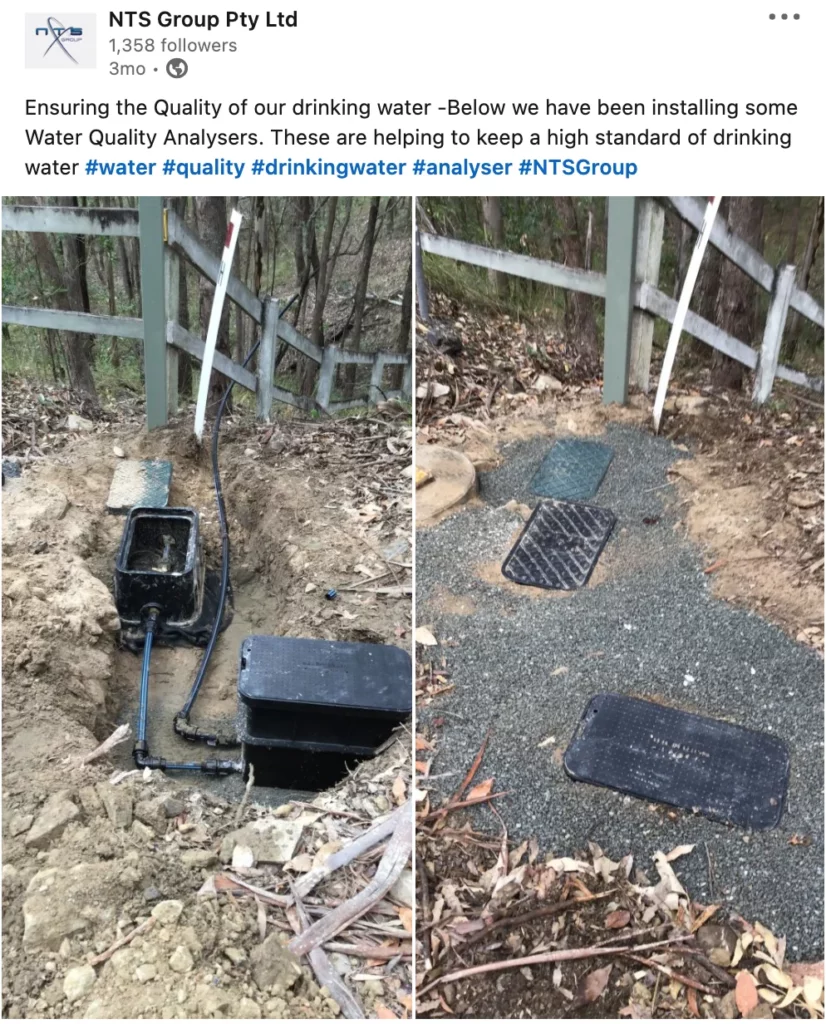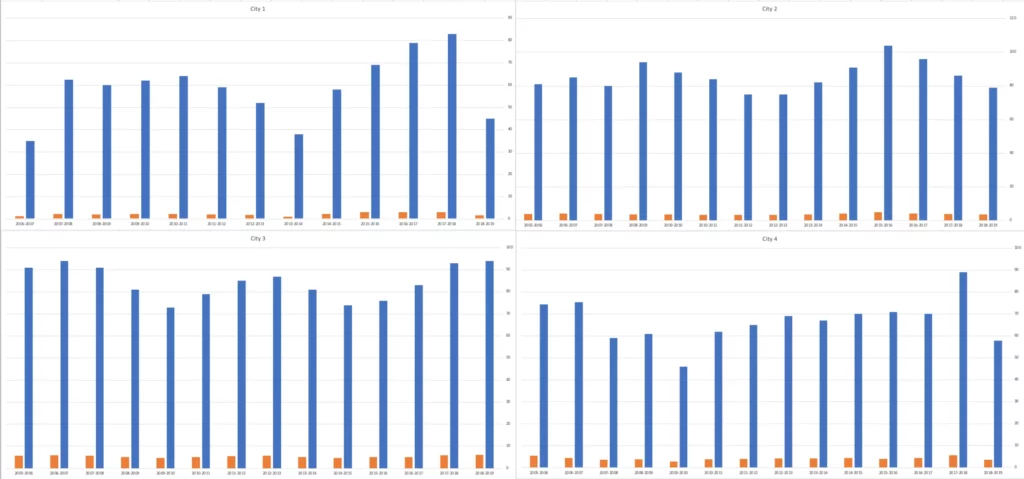The last 12 months have seen a significant shift in the way we work and the municipal water sector has not been immune — many have had to adapt to working away from the office managing field teams and a huge range of assets. While the theme of “smart water technologies” or “digital transformation” in the sector has been around for several years, the new ways in which we are working has accelerated these conversations and seen an understanding that this need is critical to the resilience of our operations. Here are 7 trends for smart water technology and approaches in Australia and New Zealand.
Here are 7 smart water technology trends I expect to see throughout 2021 in the municipal water sector in Australia and Zealand. Some of these are likely applicable in other places around the world.
1 - Need to consolidate smart water technology data in a single platform
Most water utilities in Australia and New Zealand already understand the concept and value that can be created by the use of smart water solutions — this was highlighted in 2019 when over 130 people attended the inaugural SWAN APAC Alliance Workshop. The events of the past 12 months have further emphasised the significant benefits smart solutions can provide to operate networks effectively.
The challenge with water network data is many device manufactures, brands or resellers are trying to create recurring revenue streams by ensuring their data is only accessible in their portal. Such an approach creates significant inefficiencies and erodes any value that could be created through the consolidation of data to obtain greater network insights.
In 2021, we will see a greater focus on exploring unification of IoT device data, SCADA, GIS and Smart Metering and other data in a consolidated brand-agnostic smart water platform (such as GoAigua) or building out their own (similar to Sydney Water’s EOI for software vendors to develop an artificial intelligence solution for water in 2020) to ensure proactive informed decision-making and insights can be derived across typically siloed business units.
2 - Acceleration from pilots into business-as-usual
The region has a proliferation of industry groups that undertakes water technology pilots and proof of concepts to understand how these could be used by utilities in a business-as-usual environment (one example is the recently established W-Lab, a collaboration between Isle Utilities, WSAA and ThinkPlace). For new or emerging technology, this gives them access to assets and an environment in which to test their innovation and make improvements before commercialisation. For proven solutions, including those entering the Australian or New Zealand markets for the first time, it is often a test-ground to demonstrate the technology has applicability in local conditions.
For proven smart water technologies with a demonstrable track record and a solid business case, this year will see them accelerate out of pilots and trials into use at scale at water utilities.
3 - Real-time awareness of network operation
The ability to receive real-time (or near real-time) data from a water network, for a range of parameters, allows better decisions. With the convergence of sensor, energy and communications technologies, there is now more acceptance that monitoring water networks can be achieved cost-effectively and drive improved business performance.
In 2021, following a prolonged period of where many were working from home, we will see increased demand for obtaining real-time awareness of water and wastewater network operations and performance.
Of particular interest will be real-time water quality monitoring (such as that available from TracWater in Queensland) to ensure greater regulatory compliance and to avoid any major contamination events. In recent years, we’ve seen an increase in large scale real-time monitoring projects that assist with operational decision making, particularly as many large water utilities implement the learnings from pilot and trial projects.

4 - Wider adoption of smart water meters
In Australia, utilities are exploring the value of smart water meters and the practicalities of their use, including trialling a range of network types to understand what is applicable for different parts of their network. One example is WaterGroup’s NUmeter with fully integrated NB-IoT communications ensuring low setup costs and easy deployment.
In New Zealand, they are even a step behind, with the conversation still stuck at talking about water meters period. In Auckland, they’ve had water meters since the 1990s and are charged on consumption. As a result, they use 30% less water per person than Wellington users, who don’t have meters. It has become a very political issue but to fund the considerable water infrastructure investments required in the next few decades, there needs to be wider use of metering throughout the country.
There is evidence that pricing incentives, coupled with education campaigns and regulation encourage users to conserve water. This was highlighted on the Kāpiti Coast, which saw a 26% reduction in water use since water meters, pricing and education campaigns were introduced in 2014.
The majority of New Zealand has an opportunity to skip the cycle of manual water meters and move straight to smart water meters (perhaps those from Kamstrup, which have embedded acoustic sensors to detect network leakage). We expect to see this theme across many cities in the region in 2021 as they look to leverage the power of smart metering data for demand management and water loss reduction efforts.
5 - Using smart water technology to rethink water loss management
Water loss management across Australia and New Zealand has not improved for a couple of decades. While there is the odd exception, many have seen levels of leakage in their networks remain relatively stagnant over a long duration. In 2021 we expect to see rethinking in the way water loss management projects are established, delivered and measured; with an increased focus on linking service provider compensation to results (see more about Performance Based Non-Revenue Water Contracts).
The below image shows Real Losses in MLD for four Australian cities since 2004. Blue is service connection leakage, orange is water main leakage.

The establishment of Virtual DMAs (district metered areas) will become more common in Australia and New Zealand in 2021, a concept where a water network set up with open hydraulics and the use of sensors and devices, such as insertion flow meters, to understand levels of water loss in virtual zones. This alleviates the typical problems encountered with traditional DMAs, such as water quality issues and significant upfront capital requirements. Virtual DMAs, when coupled with a powerful smart water platform, real-time monitoring and active leak detection these can make a significant impact on water loss levels.
6 - Innovation in how smart water solutions are delivered
Over the past several years, many utilities have embarked on smart water solutions in some shape or form. They understand the tremendous value they can provide to their business and operations but also understand the challenges they face when deploying innovation. For example, field activities such as battery replacements, theft, damage and communications. Smaller utilities also face a financial hurdle where the capital requirements are out of their reach to embark on smart water projects at a meaningful scale.
In 2021 we will see a move towards more innovative and collaborative delivery models where water utilities, particularly those outside major metropolitan centres, develop partnering arrangement with service providers to deliver smart water solutions more seamlessly. An example of this is the Remote-Monitoring-as-a-Service offering from Trimble Water, which eliminates the need for upfront equipment purchase and ensures ongoing data reliability under a service agreement.
7 - Increased focus on the ageing water infrastructure problem
This is a global problem and not isolated to Australia and New Zealand. When speaking about ageing water infrastructure, it is important to remember that ~70% of a city’s water assets are buried pipelines.
In New Zealand, several water and wastewater ‘events’ in recent years (e.g.: Wellington’s burst water and wastewater pipelines; Auckland’s regular beach closures due to sewer overflows; Havelock North’s 2016 campylobacter crisis) have seen increased scrutiny of the country’s ageing water infrastructure problem. A recent report noted it would cost up to NZD $50 billion over the next three decades to get the water infrastructure up to standard (that is $10,000 for every person). The New Zealand water sector is also undergoing significant reform with the establishment of a water regulator, Taumata Arowai. A Cabinet paper released in December 2020 details the reforms and is an interesting read if you have a spare hour or so (PDF can be found here).
Australia faces similar challenges with its ageing water assets. A very deliberate, but important, focus on customer satisfaction and experience has led to heightened scrutiny when things go wrong. Burst water mains cause significant disruption to our communities and the ability to reduce these, and/or be more proactive in preventing them, has a significant flow-on impact to our communities. (All cities face broken water mains, here are some recent ones from Tasmania, Townsville, and Gold Coast).
In 2021 we expect to see a continued trend towards undertaking condition assessments of these critical water mains and sewer rising main assets to optimise renewal decision making and prevent disruptive asset failure. One solution that will assist is KenWave Pipeline Condition Assessment technology, which is non-disruptive and non-invasive and allows for a range of materials and diameters to be assessed so a better understanding is obtained to avoid disruptive pipeline breaks.
About Aqua Analytics
We help water utilities in Australia and New Zealand with their smart water network, water loss management and pipeline condition assessment projects throughout Australia and New Zealand.
More information at: www.aquaanalytics.com.au, [email protected], (AU) 1800 264 262, (NZ) 0800 345 697.
-Originally published on 5 January 2021


